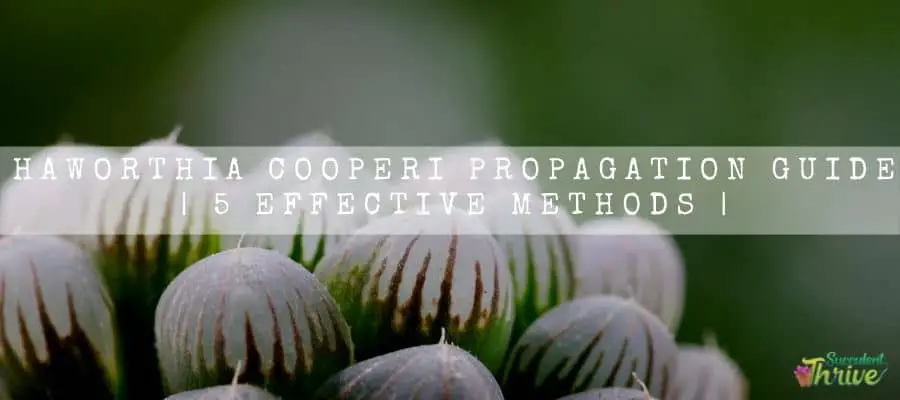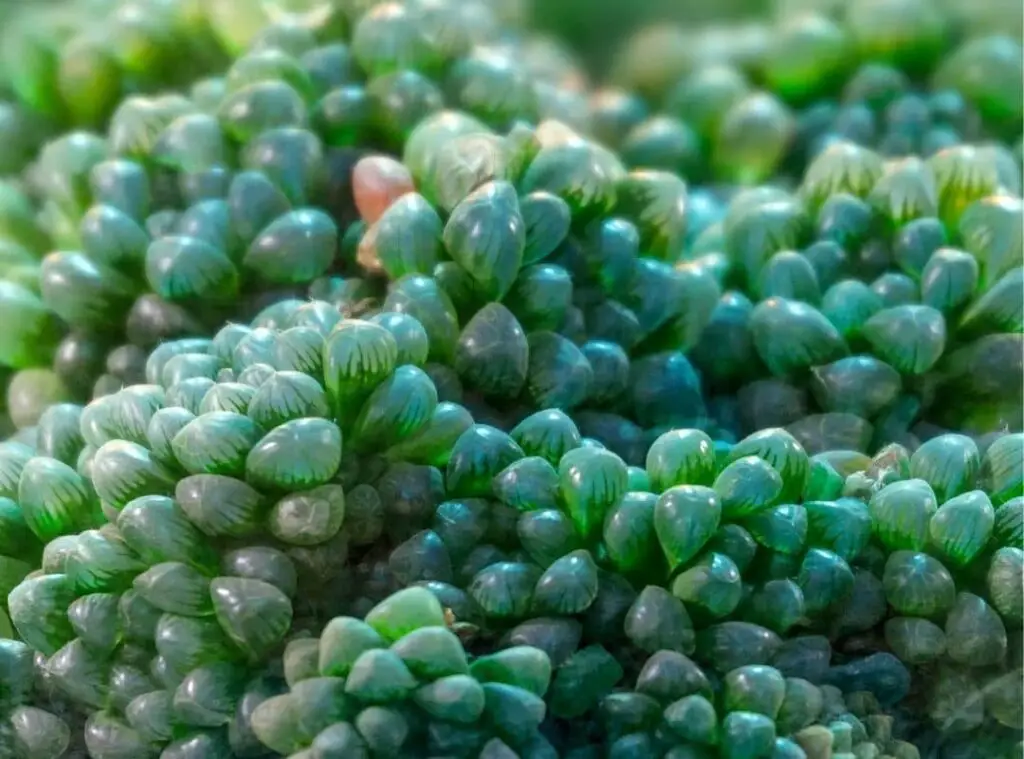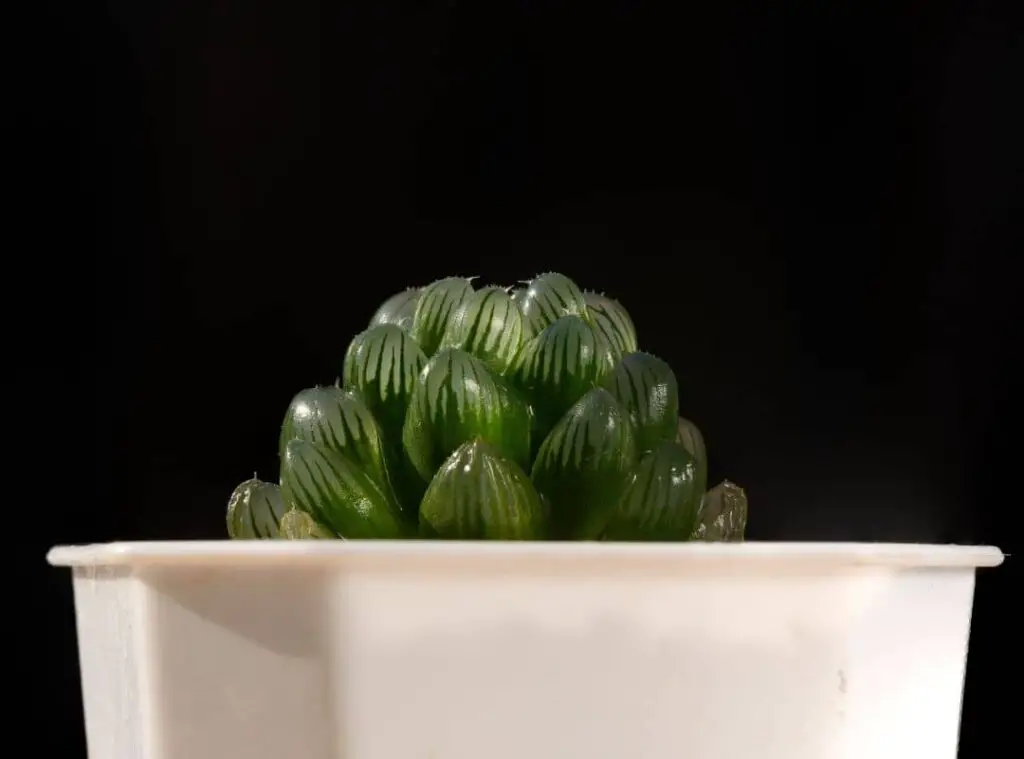If you are excited to find out Haworthia cooperi propagation methods, continue reading this article as it would help you to enhance your knowledge.

About Haworthia cooperi
Haworthia cooperi plants are a rare yet attractive succulent that any gardener would love to have.
They are somewhat in contrast to the typical Haworthia plants. They tend to resemble the look of a mini aloe which comes up with rough edged leaves.
Haworthia cooperi plants form a rosette shape along with surreal bulbous leaves. Many people tend to think Haworthia cooperi plants are originally made from blue-green marbles.
Haworthia cooperi plants can be easily maintained and they are small. They would be great picks as mantlepiece plants.
Furthermore, many succulent enthusiasts prefer to grow them in ceramic containers. Haworthia cooperi plants are endemic to South Africa and they are special as they can thrive well in different lighting levels.
This is a famous indoor plant among succulent enthusiasts. One more value addition of having these plants is their flower blossoming.
Last but not least, Haworthia cooperi plants are pet friendly and resistant towards diseases and for pests attacks.
You can buy this beautiful succulent from here
Can you propagate a Haworthia cooperi propagation?
Haworthia cooperi plants can be propagated by using stem cuttings, leaves and from offsets as well.
In addition to that you could propagate them while using water or soil as a growing medium too. Best time to conduct Haworthia cooperi plant propagation is during spring to summer.
Haworthia cooperi propagation via stem cuttings
- To start off you need to first snip off the Haworthia cooperi plant’s stem depending on the length you wish to have it whilst using a disinfected sharp pair of scissors or disinfected pruning shears.
- Ensure that your cut off stem has at least one or two leaves.
- Further, if there is any old root present in the stem, it is best to get rid of them before proceeding any further.
- To do that you could either slide them away from the new shoot or use your fingernail or thumb to remove them.
- Refrain from pulling off the roots as it could be harmful for the plants.
- Next arrange a pot which has a depth of at least 6 inches which is filled with soil mix.
- You need to fill the soil mix at least for a depth of 2 inches.
- Consequently, it will help the roots to grow firmly and vigorously. You could lightly water the soil mix to make the top layer of the soil moist.
- After that, you may plant the cuttings horizontally in a depth of about one third of your planter so that it will help the roots to grow downwards and establish firmly when they are fully grown.
- If you plant them vertically, it is very unlikely that plant roots grow firmly as they do when grown horizontally
- As the next step, you need to cover the cuttings along with a sphagnum moss layer.
- The pot you are using for this purpose should be slightly larger than the plant size. Avoid using pots that are way too larger than the plants as it could retain excess water within the pots.
- You should place the specimen in a spot where they can gain direct full sunlight for about 4-6 hours preferably in the morning.
- I encourage you to mist them lightly on a constant basis so that you could create a humidity level of at least 60 %.
- After some time, you could consider watering the specimen sparingly too.
- Do not water them in abundance as it could make the plants vulnerable for root rot and for other fungal and bacterial infections as well.
- You could continue with the regular care treatments afterwards.
Haworthia cooperi propagation via Leaves
- If you wish to propagate the Haworthia cooperi plants by using their leaves, first you need to cut a few leaves from the plants which are healthy and plump.
- I recommend cutting the leaves from the base of the plant and obtaining the leaves under the node.
- Next, leave them in a warm place for a couple of days which will allow them to develop callousness.
- It is important that you leave them in a dry place to develop calluses as it will make the plants less prone for fungal and bacterial attacks.
- Once this is done, you could plant them in a pot 2 inches away from each other.
- The soil mix should be a sterilized moistened one. Your potting medium should be a blend of succulent soil mix, perlite and peat moss as well.
- When you place the leaves do not press them too much. Instead, you need to assure that it is slightly in contact with the moist soil.
- Ensure that your soil mix is moist and not too soggy. Unless it could make the plant vulnerable to root rot.
- You could either water them in the morning lightly or mist them. Place the specimen in a shady place.
- Avoid covering the tray with plastic as it could create mold. You could spot them forming roots within 6-8 weeks of time.

Haworthia cooperi propagation via Offsets
- These plants produce offsets around the base of their plants as they mature.
- Once they are matured enough you could repot them. When repotting you could just segregate the pups from the mother plants.
- Offsets grow connected to the mother plants and you could cut their adjoining part to the mother plant by using a sharp sterilized knife.
- Be vigilant when you make the cutting unless the leaves will fall off.
- Ensure the cut offsets are carrying a few roots so that the new plant can establish faster.
Do they produce seeds?
Haworthia cooperi plants do produce seeds and you could even use them to propagate them as well.
To propagate them through seeds, you need to put a container in an oven at a temperature of 80-100 degrees Celsius for about half an hour and then sow the seeds on the surface.
Next you could cover it with a layer of coarse-grained particles. It would usually take about 6 months to reap the harvest.
Can you root Haworthia cooperi propagation in water?
You can propagate the Haworthia cooperi plants in water. The mode of doing it in water is similar to the mode of doing it in soil.
However, the only difference is the growing medium you use in the water propagation is water.
You could take a jam jar and place a thick wad of sterile cotton callused wool in the jar. You could apply water until you make the cotton wool wet.
Next you could stick the calloused stalks in the cotton wool and keep the leaves closer to the lid edge.
You could leave the specimen like this for a few weeks, and you will spot them forming translucent roots. When the roots have fully established you could grow them in individual pots.
How to treat after propagation
Soil
Haworthia cooperi plants are fond of growing in soil mixes which are fast draining.
If you are looking for an easy way of obtaining a fast-draining soil mix, the best is to purchase a cactus potting mix from the garden stores.
If you think you need to further improve the draining of the soil mix, you could consider adding perlite or pumice into the soil mix.
Alternatively, you could make a fitting soil mix on your own by blending potting soil, coarse sand and perlite at balanced amounts.
Once you provide a well-draining soil mix, it will make sure that excess water is not stored in the potting medium and instead it’s draining away.
You could use elements such as charcoal chunks, aquarium gravel and shredded bark instead of perlite.
Light condition
Haworthia cooperi plants require bright yet indirect sunlight to perform well.
If you expose them to direct full sunlight it would be harmful for the Haworthia cooperi leaves’ translucent windows.
It would be unhealthy for the plants since those translucent windows are what affect the photosynthesis of the plants.
Haworthia cooperi plants grow in shady places when they are in their natural habitat.
As such when you grow them as houseplants, you need to ensure that they get the same conditions as they grow in the wild. It could possibly be a bright sunny window.

Watering
Haworthia cooperi plants require only a limited amount of watering from you just like the rest of other succulents and the cactus in general.
They could survive without water for a few weeks. So, if you are someone who does not have a lot of time to spare on gardening, you could go ahead with gardening these plants simply because they could thrive well even if you forget to water them.
In terms of the frequency of watering, it could be once a week during summer where the water evaporation is faster.
On the other hand, you need to minimize watering them during winter for about once a month. If you are unsure whether you need to water them or not, the best is to wait for some days and then water.
Growing the Haworthia cooperi plants in a pot which has a draining hole is also quite crucial so that it would not retain excess moisture in the pot.
Temperature
Haworthia cooperi plants used to grow in hot and dry weather conditions.
Hence if you wish to add them as indoor plants, ensure that you are giving them warmer temperatures. If you live in subtropical zones, you could consider growing them outdoors.
The best average temperature would be 68-72 degrees Fahrenheit. Having said that, they can withstand temperatures of 90 degrees Fahrenheit as well.
However, do not leave them exposed to temperature below 40 degrees Fahrenheit as it could cause frost damage to your plants.
Humidity
Haworthia cooperi plants can withstand high levels of humidity to low levels given that the moisture around the roots is managed well.
It is important that your Haworthia cooperi plants have a good aeration so that it would not make the plants vulnerable to root rot.
Fertilizer
Haworthia cooperi plants do not require a lot of feeding. They could perform well even with low levels of fertilizers.
Having said that If you have matured you could proceed with a balanced succulent fertilizer.
Related question
How do you root Haworthia cuttings?
Dip the cut end in a rooting hormone to boost the root formation. Keep them in a warmer place which will allow the leaves to develop callous.
Next you need to go ahead and plant them in an appropriate soil mix and leave them in a place where they can gain bright and indirect sunlight.
How do you separate Haworthia Cooperi pups?
You need to first arrange a pair of scissors, metal gardening shovel soil and a new pot to place the pups in.
First of all, select the pups you want to remove. Place your shovel and try to remove the plant. Whilst you take the plant, you will come across a couple of red cords.
Then you should grab your scissors and snip them off.
Keep pulling the pup gradually and do not damage the roots while you are doing this. After that you could fill a pot with potting soil and dig a hole and plant the pups in.
Keep adding more potting soil so that it will stay stable in the pot.
Does Haworthia need sunlight?
Haworthia cooperi plants enjoy growing in bright indirect sunlight. Further they could thrive well in partial shade as well.
How long does it take Haworthia to root?
You could expect the Haworthia cooperi plants to root within 0ne and half weeks to two weeks’ time.
Conclusion
So, before we conclude this, you would have understood how wonderful your Haworthia cooperi plants are and how easy they are to propagate them.
To sum up, you could use their leaves, stem cuttings and even offsets to propagate them. Make sure you practice the aforesaid after care treatments also so that you will get the best results of the propagation process.
So, why wait , start propagating the Haworthia cooperi plants and try to share them with your friends also.
Read Next : Echeveria Perle Von Nurnberg Propagation | 5 Effective Methods | Sedeveria Lilac Mist Propagation | 3 Effective Methods For You | Succulent Heart Propagation Guide | 4 Effective Methods |
